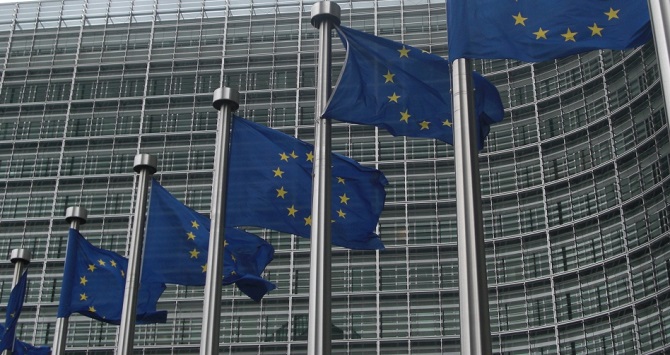 LSE’s Professor Robin Mansell assesses the European Commission’s new Digital Single Market strategy, launched last week, looking at its goals, strengths, limitations and chances of success.
LSE’s Professor Robin Mansell assesses the European Commission’s new Digital Single Market strategy, launched last week, looking at its goals, strengths, limitations and chances of success.
The Digital Single Market (DSM) Strategy for Europe, launched 6 May 2015, is ambitious and comprehensive. The aim is to position Europe as a world leader in the digital economy. It is a big effort to join up thinking. This is essential and it offers a coherent roadmap with 3 pillars: better access; creating conditions for a level playing field; and maximizing growth potential, plus 16 actions, all aimed at ‘every consumer getting the best deals and every business accessing the widest market’ as Commission President Juncker says.
The stakes are high – it is claimed that the DSM could generate EUR 415 bn by 2019 and many thousands of new jobs. These gains will be foregone if change does not happen, and happen rapidly. The DSM and its accompanying Staff Working Document (SWD) are frustrating. Like all good strategies, it is long on problem identification and short on specific directions, especially on the wicked problems. Still, the DSM is a ‘call to arms,’ highlighting that:
- Telecom network operators are not investing fast enough in high-speed broadband
- High speed broadband is unevenly available across Europe
- The digital skills base is not what it needs to be – ‘39% of EU citizens have only low or no digital skills’ and there could be a shortage of 825,000 ICT professionals by 2020
- Almost half of Internet traffic goes to the only 1% of actively trading websites in the EU
- Only around 7% of companies with more than 10 employees are using big data analytics
- Only one of the top 20 big data companies on the global market is European owned
- Only 1 out of the top 10 providers of cloud computing is based in Europe.
(data from Staff Working Document)
So what should we make of the DSM?
A first observation is the absence of comparative data with major trading regions. Other regions also face the consequences of digital disruption. They also face high speed broadband roll out challenges; skills deficits, and the need to balance incentives for competition and innovation. Comparison is essential to underpin new measures and evaluate their potential consequences.
A second observation is that the DSM refers to multiple areas where action is needed. It states familiar goals, but it barely hints at the direction of travel to fix them. As a well-honed political document, it lays out choices. For instance, ‘the Commission will propose solutions which maximise the offers available to users and open up new opportunities for content creators, while preserving the financing of EU media and innovative content’. The Commission wants a strong, competitive and dynamic telecoms sector and to boost innovation in cloud computing, big data tools and the Internet of Things, but it says that the online market power of some platforms ‘raises concerns … becoming increasingly critical’. The DSM wants to be all things to all stakeholders.
A third observation is that telecoms operators, the audiovisual industry, and ‘platform’ operators are all discussed in the strategy document. Thinking has shifted enough now to acknowledge that they do not occupy different worlds. The fact that this is increasingly the case is the crux of the problem. How it is tackled has huge implications for all stakeholders, including consumers and citizens. The DSM acknowledges that ‘telecoms operators compete with services which are increasingly used by end-users as substitutes for traditional electronic communications services … which are not subject to the same regulatory regime’. There is a need for a level playing field. For audiovisual media, the DSM recognizes that traditional television and on-demand media are also not subject to the same rules.
Again when it comes to change, political pitfalls are circumvented. Two pathways exist:
‘enhance the overall level of protection from harmful material through harmonised implementation and enforcement of the conditions which allow online intermediaries to benefit from the liability exemption’,
or invite intermediaries to:
‘exercise greater responsibility and due diligence in the way they manage their networks and systems … so as to improve their resistance to the propagation of illegal content, increase transparency and thereby confidence in the online environment’.
One reason for uncertainty about what rules to apply in which industry segment is the expansion of the platform business model into the digital services ecology. But a fourth observation is that the Commission is not yet drawing on the growing evidence base on the consequences of platform growth and consolidation. Evidence already exists in Europe in the academic literature, from scholars including Damian Tambini, Annabelle Gawer or Pieter Ballon. To be fair, research from the Harvard Berkman Center is cited, but evidence on platforms comes mainly from McKinsey and other consultancies that do not provide the rounded analytical insight that is needed.
As Inge Graef says, the question of balancing market stimulation through EU regulation versus corporate self-regulation and governance raises the wicked problem of what is too much or too little regulation? Another question is whether a level playing field really is desirable? Would it be better to have a few strong players in Europe that can tackle the global market, or multiple smaller players in niche markets in the digital ecology? In the Commission’s words,
‘policy makers have to keep pace with rapid innovation, often of a disruptive nature (such as the rise of the “sharing economy”), and balance risks with intelligent regulatory and governance models preserving the values of our societies’.
Hedging by offering a menu of solutions continues through the discussion of platform intermediaries. There is a definition of platforms, recognition that they can become very large (due to network effects) and ‘act as key players’, that they can be ‘among the most influential of digital actors’, and that this gives them the ‘power to shape the online experience’. Issues of strategic control of platforms and fundamental rights to data protection and privacy are noted, as are low levels of customer and citizen awareness about use of their data, and scarce information provided to website visitors. But content diversity is mentioned mainly in relation to copyright, and the plurality of the news content available to citizens as a result of the platform market configuration is not.
This leads to a fifth observation. A strong evidence base clearly is needed to underpin the DSM strategy. There is a need for an economic rationale for action and a defensible one. But evidence is also needed on that which cannot easily be modeled. Put differently, there is a need for consideration of a range of evidence on the economic and political, cultural and social consequences of changing the regulatory landscape. The Commission is to undertake an assessment of the role of platforms, how different types of platforms work, their effects on customers and on the economy as a whole.
This is important, but research needs to be funded and undertaken on issues beyond questions about the economic dynamics of the platformized digital environment. It also needs to go beyond asking whether more transparent information needs to be provided to consumers and it needs to take consumer interests in their capacity as citizens into account. Pushing more and more responsibility onto platform users as citizens or consumers to inform and protect themselves when it they are already with details in terms of use statements and in the fine print of privacy protection statements is unlikely to resolve the structural weaknesses in the European marketplace.
Limitations of the DSM strategy
As long as the balance is tipped towards helping consumers and citizens inform and protect themselves individually in relation to content, contract conditions and the use of data, the less likely it is that the problems created by distorted markets in Europe will be tackled effectively. Supply side problems need to be tackled from a multidisciplinary perspective that includes attention to social and cultural values, not only economic value. If this does not happen, reform may happen, but it is not likely to respect the full range of goals of the European Digital Agenda. There will be little that European policy can do to shape developments unless the supply-side issues are addressed. Despite the high political priority accorded to the Digital Single Market, policy makers will remain on the back foot, struggling to catch up with the dominant market players. The success of the new Digital Market Strategy will depend on choices and directions taken towards implementation along pathways that boost economic prospects for the stakeholders based in Europe and that respect social and cultural public interest values.
The fundamentals still need sorting, despite the welcome comprehensive treatment of issues in the DSM. These fundamentals include how to put incentives in place to encourage building accessible high bandwidth networks; decisions about what should be regarded as universal access; reducing switching costs for consumers; and oversight of delegated authority to platform intermediaries for protecting privacy, managing personal data, and taking down content. This is not all. The changes in the legislative and regulatory landscape need to ensure that the outcome of reform is a sustainable public sphere, enabled by diverse content, especially news, which is well-financed and easily accessible to citizens.
There will be a public consultation. It is essential for those whose research addresses these fundamental issues to ensure that a much higher profile is given to evidence that comes from a variety of disciplines of inquiry; inquiry that considers not only the economic dynamics of the global and European market, but also the social and cultural outcomes of mediated life that results from reform.
This post gives the views of the author and does not represent the position of the LSE Media Policy Project blog, nor of the London School of Economics and Political Science.





